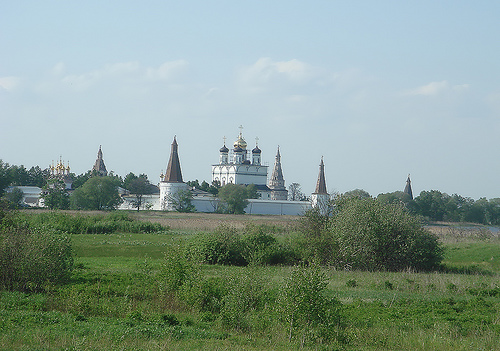

Location: 17 km Northeast of Volokolamsk, Moscow Oblast Map
Established: 1479 by Joseph Volotsky
Joseph-Volokolamsk Monastery is a Russian Orthodox monastery
is located 17 km Northeast of
Volokolamsk in Moscow Oblast in Russia. It was established in
1479 by Joseph Volotsky. Joseph-Volokolamsk Monastery is a medieval Russian
Orthodox convent that was founded in 1479 by Saint Joseph of Volokolamsk.
By the middle of the XVI century, the monastery became one of the
richest in Russia, as it was patronized by Tsar Ivan the Terrible. The
oldest building of the Joseph-Volokolamsk Monastery is a monumental
refectory, built in 1504. It is an one room, structure, modeled after
the Moscow Kremlin's Faceted
Chamber. North side of the refectory is believed to be a burial site
of Malyuta Skuratov. He became famous as one of the worst henchmen of
Ivan the Terrible. Fortunately for Russians he was killed in 1573 during
a siege.
Assumption Cathedral of Joseph-Volokolamsk Monasterywas built in the
late XVII century at the expense of the deacon Zachariah Silin. The
Cathedral is a square in layout and richly decorated with tiles,
friezes, columns, domes with the original tent roof. Inside the
cathedral is dominated by miraculously preserved carved iconostasis of
the XVII century adored by golden columns. Basement of the church also
holds a crypt with the body of the monastery founder, Saint Joseph of
Volokolamsk. Most of church's frescoes date back to the early 20th
century. It was painted by Palekh masters in pseudo- medieval style.
Five-domed Gate Church of St. Peter and Paul was completed in 1589
thanks to contributions of Malyuta Skuratov that he left to the
monastery in his will. It is largely kept its historic appearance and
undergone very few changes.
Outside defensive wall and towers date back to the middle of the XVII
century. New walls replaced military medieval fortifications that were
badly damaged during the Time of Trouble in the late 16th and early 17th
century. At the time of the construction these walls and towers were
still used for military defense, but monastery residents added figural
polychrome brickwork and tiles to improve its appearance and make it
more festive.
At the end of the XVII century, the monastery bell tower was erected
reaching a height of 10 levels. Its height was only five meters below
bell tower of
Ivan the Great in the Moscow
Kremlin, what was the tallest building in
Moscow for several centuries. The
bell tower was blown up during the World War 2. Today only few ruins are
visible today under a protection of a wooden canopy.
Joseph-Volokolamsk Monastery had always a dual service. On one hand it
was a religious convent. But on the other hand premises of Joseph-Volokolamsk
Monastery served as a dungeon for political and war criminals. In
different times it house political prisoners like Vasily Shuisky,
artists like Maxim the Greek, Polish and Napoleonic French prisoners of
war.
In 1920 Joseph-Volokolamsk Monastery was closed by the atheist government and only in 1999 Monastery was returned to the Russian Orthodox Church.